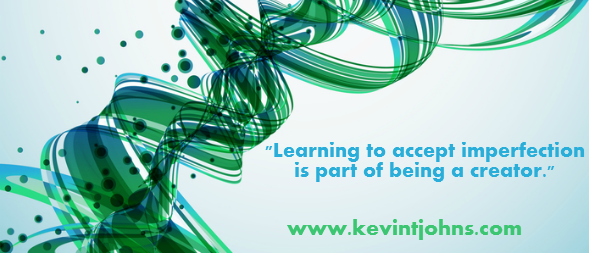Perfectionists.
Sigh.
You guys drive me crazy.
All through high school, I played guitar in punk-rock bands. The punk-rock scene is where my artistic sensibilities were defined. When I create art, perfection is the last thing on my mind. I strive to achieve passion, energy, honesty, connection, revolution… but not perfection. From a punk-rock perspective, there is something unsavoury about a slick work of art, something untrustworthy about an over-produced work. It’s those rough edges that make a song, story, or painting interesting – at least that’s my take.
I’ve worked with enough struggling writers, however, to know that some of you reading this right now believe that if you redraft your manuscript just one more time, or get just one more beta reader to go over your story and provide feedback, your book will finally be perfect.
Maybe the kind of perfection you’re worried about is all about your own standards—or maybe you’re worried about whether others will see your book as perfect. Either way, I’m here to tell you: what you are doing is futile. Art is rarely perfect in the eyes of the artist. Learning to accept imperfection is just part of being a creator.
What Leonardo da Vinci Can Teach You About Perfectionism
You are no doubt familiar with the painter and inventor Leonardo da Vinci, but what you may not know is that there are just fifteen completed paintings by Leonardo in the entire world.
Why did this brilliant master complete so few works? This might have something to do with what Paul Valery had to say about artists like Leonardo: “In the eyes of those lovers of perfection, a work is never finished—a word that for them has no sense—but abandoned; and this abandonment, whether to the flames or to the public (and which is the result of weariness or an obligation to deliver) is a kind of an accident to them, like the breaking off of a reflection, which fatigue, irritation, or something similar has made worthless.”
As Valery suggests, it is likely Leonardo rarely reached a point where he felt as if his art was finished and perfect. Instead, like all artists, he was forced to eventually abandon works that he considered “unfinished”.
Now, to put thing in a bit of perspective, let’s ask ourselves, what might some of these “unfinished” works of art have been?
The Vitruvian Man
The Last Supper
Mona Lisa
Thank goodness we have these “unfinished” works of art; given that they are now regarded as some of the greatest art ever created, icons of the High Renaissance, and monuments of Western civilization.
The Perfect Special Editions
While we’re discussing non-literary examples, let’s look at the science-fiction film series Star Wars for a moment.
On its release in 1977, the original Star Wars movie instantly became one of the most financially successful and beloved films of all time; and its two sequels, The Empire Strikes Back and Return of the Jedi, were also well loved. Yet, despite all the success of the original trilogy, director George Lucas felt compelled, in the late 1990s, to go back to the films and make changes to them.
In interviews at the time, he explained that film and digital technology had finally caught up with his original vision of what Star Wars was meant to be, and he would now be able to produce his perfect version of the films.
How did Star Wars fans respond to these “perfect” special editions?
They hated them!
“Han Shot First” became a cultural meme, and the anger that was rampant amongst fans continues to this day.
Lucas didn’t know when to leave well enough alone. As happened with Leonardo and his paintings, Star Wars, in Lucas’s eyes, wasn’t perfect—but, in the eyes of millions of fans, me included, those films were perfect. They were treasured works of art that defined our childhoods and sparked our imaginations. By messing with those films, Lucas desecrated something that was precious to a great many people.
As an artist, you can find it extremely difficult to let go of your art and send your voice out into the big, bad world to live or die on its own. But you have to do it. You must not let fear and perfectionism hold you back. As an author, at some point, you simply must type those two special words: “The End.”
Polishing Perfect
Author, marketer, and massively popular blogger Seth Godin wrote a short blog post, titled Polishing Perfect, in which he directly addressed this fear of releasing a less than perfect product. In the post, Godin argues that when you succumb to the fear of releasing a less then prefect creation into the world, you’re holding back the good stuff from the people who need it, because you fear what the people who don’t need it will say.
And that’s a real shame.
Don’t let fear of releasing a less than perfect work hold you back. As Godin says, do the work, and then ship it.
***
This article is based on a chapter from the book Smash Fear and Write like a Pro. Click here to learn more about the book.

Kevin T. Johns is an author, writing coach, and ghostwriter. He helps authors from around the world get their stories out of their heads, onto the page, and into readers hands. Grab a free copy of his short guide for authors by clicking the image below.






